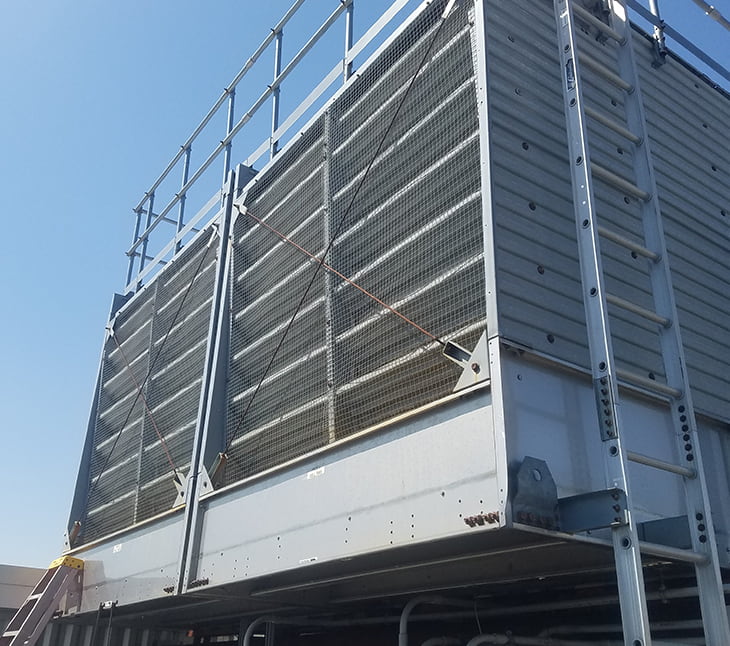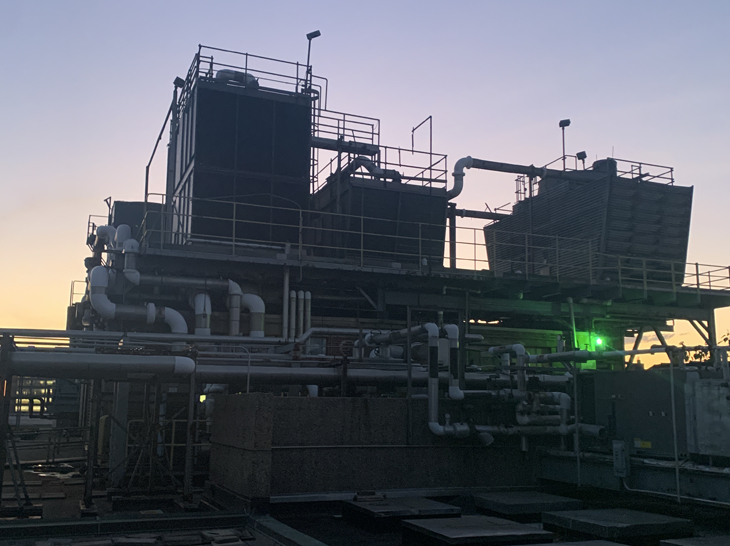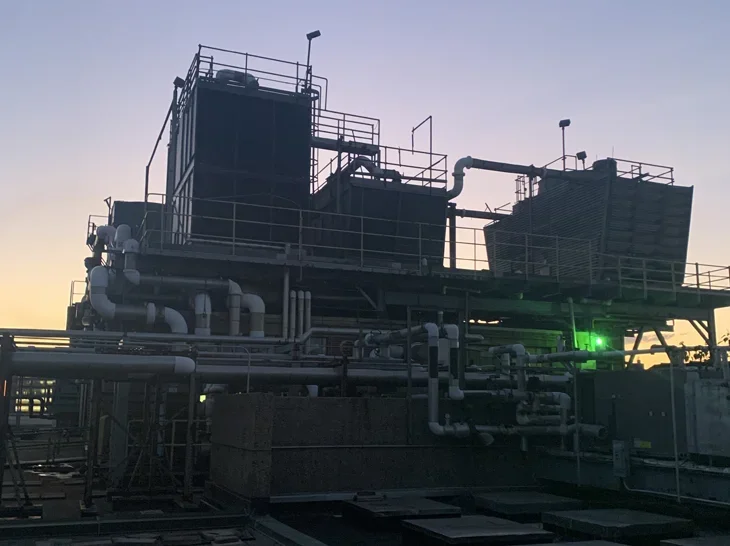
Cooling Tower Water Treatment Best Practices: Tips for Effective System Maintenance
Optimizing your cooling tower’s performance is crucial for health, safety, efficiency, and cost management. A well-executed cooling tower water treatment guarantees effective biological control, enhanced heat transfer, corrosion prevention, and reduced operational expenses.
Professional cooling tower treatment centers on vital elements: biological control, scale inhibition, and corrosion protection.
Preserving your cooling tower’s optimal function requires routine upkeep and prevention of microorganism growth. If your maintenance plan lacks periodic cleaning, it will fall short in maintaining peak performance.
Apart from nurturing harmful bacteria, unclean cooling towers can attract debris through the system’s pipes, thereby undermining overall efficiency.
Understanding Cooling Water Treatment
The best approach to cooling tower water treatment is recognizing that a one-size-fits-all strategy won’t work. Tailored plans that take into account your specific needs, historical treatments, and unique factors, on the other hand, will deliver optimal results.
These factors encompass equipment quality, construction materials, flow problems, and current maintenance conditions. Seasoned professionals will then design a personalized proposal, addressing these factors efficiently while minimizing expenses and stress.
Best practices dictate that cooling tower water treatment aligns with the facility’s specific requirements and current state.
Following these practices will help you safeguard your cooling tower system against harmful elements like bacteria, Legionella, corrosion, and scaling. And that’s not all!
It pays off with reduced bills and fewer long-term costs. Moreover, the dual goals of ensuring safety and environmental responsibility by curbing water wastage are addressed.
Importance of Effective Maintenance
Maintaining your cooling tower’s water quality results in more than just cleanliness. Effective water treatment is the key to safeguarding your cooling tower system against corrosion, scale formation, and microbial proliferation. Neglecting treatment allows bacteria and algae to thrive, ushering in corrosion due to their acidic byproducts and a host of other issues.
Scale buildup and corrosion can wreak havoc on your cooling tower and its components. While a clean tower inhibits scale and corrosion, only diligent water treatment can stave off pH imbalances. High pH levels signal the presence of dissolved carbonates and bicarbonates, leading to scale. Conversely, low pH levels mean acidic water will corrode or damage metal components. Professional water treatment ensures the right pH balance, enabling optimal system performance.
Water treatment isn’t a one-time affair; it’s an ongoing endeavor. The products used to prevent bacterial growth and maintain pH balance necessitate continual monitoring and application. Do consult your local water treatment experts for the ideal maintenance schedule for your cooling tower.
Water Quality Monitoring
As mentioned, continuous water quality monitoring is essential for the efficient operation and maintenance of cooling towers and their associated systems in buildings. These towers play a vital role in maintaining the temperature of water used in various industrial processes, but their purpose relies on consistently high water quality.
Monitoring parameters like pH levels, conductivity, and microbial growth are crucial. pH levels need to be within a specific range to prevent corrosion and scaling, while conductivity ensures the proper dissipation of heat. Controlling microbial growth is imperative to avoid biofilm formation, which can reduce cooling efficiency and pose health risks.
Regular monitoring not only maintains system efficiency but also facilitates early issue detection, preventing costly downtime and system damage. In the complex world of cooling tower systems, continuous water quality monitoring is the key to smooth operation and cost-effective water treatment.
Industrial Cooling Tower Best Practices
Cooling towers play a pivotal role in maintaining the temperature of various industrial processes, including power generation, manufacturing, and HVAC systems. Let’s explore the key aspects that can help optimize your cooling tower’s performance:
1. Remove Scale Deposits
Scale deposits can hinder heat transfer and reduce cooling tower efficiency. Regularly descale the cooling tower to prevent scaling issues.
2. Maintain Constant Airflow
Ensure that the cooling tower’s fans and louvers are in good working order to maintain consistent airflow and heat exchange.
3. Check For Clogs
Regularly inspect and clean the tower’s water distribution system, nozzles, and fill to prevent clogs that could impede the cooling process.
4. Test Your Water Pump
A well-functioning water pump is essential for proper water circulation. Regularly check and maintain the pump to avoid disruptions in the cooling process.
5. Treat Your Water
Employ effective water treatment methods to prevent corrosion, scaling, and microbiological growth within the cooling water tower system. This ensures the longevity of the equipment and efficient heat transfer.
6. Routine Inspection and Maintenance
Schedule routine inspections to identify and address issues before they escalate. This includes checking for leaks, worn components, and structural integrity.
7. Water Quality Management
Monitor and control the quality of the water in the cooling tower to prevent fouling and microbiological growth, which can reduce efficiency and lead to system contamination.
8. Energy Efficiency
Implement energy-saving measures such as variable speed drives for fans and pumps to reduce power consumption and operating costs.
9. Preventing Microbiological Growth
Use biocides and other microbiological control methods to prevent the growth of harmful bacteria and algae in the cooling tower water.
10. Scale and Corrosion Control
Employ scale and corrosion inhibitors to protect the tower’s components from damage, preserving its operational efficiency.
11. Environmental Considerations
Adhere to environmental regulations and consider eco-friendly options for water treatment and system operation to minimize the environmental impact of your cooling tower building.
Understanding the purpose of cooling towers and applying these best practices will help you maintain a reliable and efficient system. By following the above guidelines, you can ensure that your cooling tower operates optimally, saving energy and resources while extending its lifespan.
Benefits of Regular Maintenance
Regular maintenance is the cornerstone of ensuring the optimal performance of cooling tower systems. Mentioned ahead are a few benefits to look forward to.
1. Enhanced Cooling Tower Efficiency
Routine maintenance, including cleaning and inspecting components, can optimize heat exchange and airflow. This, in turn, can boost the cooling tower’s efficiency in removing excess heat from industrial processes.
2. Prolonged Cooling Tower Lifespan
Proactive maintenance helps prevent corrosion and scale buildup, extending the lifespan of cooling towers. By replacing worn-out parts promptly, you can ensure that your cooling tower system operates reliably for years.
3. Energy Savings
Efficient cooling towers consume less energy, reducing operational costs and promoting eco-friendliness. Well-maintained systems work more effectively, ensuring that the energy used is not wasted.
4. Minimized Risk of Downtime
Regular inspections and maintenance can help detect potential issues before they escalate, reducing the risk of unexpected downtime and production disruptions.
5. Water Conservation
Effective maintenance practices, such as proper water treatment, can minimize water loss and chemical usage. This, in turn, can aid water conservation efforts, which are essential for sustainability.
6. Safety and Compliance
Maintenance is a great way to ensure compliance with safety regulations and standards, reducing the risk of accidents and environmental harm.
7. Cost-effective Maintenance
Regular maintenance is cost-effective in the long run, as it can prevent costly repairs and replacements, saving both time and resources.
8. Improved Air Quality
A well-maintained cooling tower can help control airborne contaminants, improving the quality of the air around the cooling tower building and ensuring a safer working environment.
9. Environmental Responsibility
It’s no secret that sustainable maintenance practices contribute to environmental responsibility by reducing waste, water consumption, and energy usage.
Conclusion
Optimal cooling water treatment maintenance is crucial for businesses relying on cooling towers. Regular maintenance ensures peak efficiency and reliability of your cooling tower system. Maintain cleanliness, address scale, and corrosion issues, and monitor water quality to extend the life and functionality of your cooling tower. Make sure to prioritize these measures to safeguard your operations and investments.
Related Blog
-

Understanding the Importance of Generalized Water Testing
It’s no secret that water is an essential aspect of our lives. From drinking and cooking to showering and cleaning, water is a vital resource
-

The Importance of Closed and Process Loop Services: Maximizing Efficiency in Industrial Systems
Hydronic heat transfer systems have been the backbone of industrial cooling systems for a long time. But as energy costs rise, industrial cooling systems are
-

What is the Cooling Tower Water Treatment Program?
Cooling towers are key to many commercial and industrial settings, such as power plants, factories, and manufacturing facilities. They work by cooling water to keep
